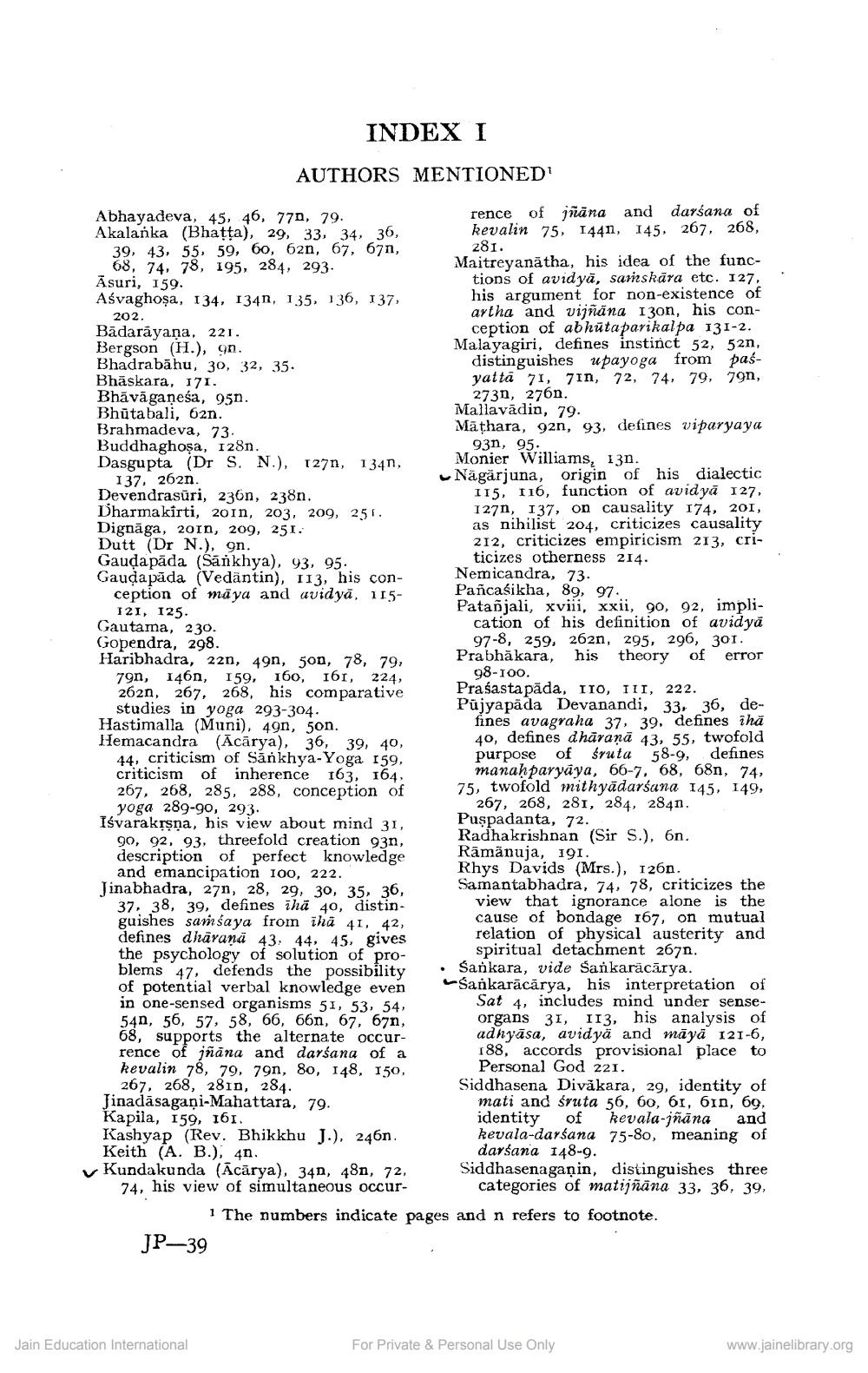________________
Abhayadeva, 45, 46, 770, 79. Akalanka (Bhatta), 29, 33, 34, 36, 39, 43, 55, 59, 60, 62n, 67, 67, 68, 74, 78, 195, 284, 293. Asuri, 159.
INDEX I
AUTHORS MENTIONED1
Asvaghosa, 134, 134, 135, 136, 137,
202.
Badarāyaṇa, 221. Bergson (H.), gn.
Bhadrabahu, 30, 32, 35.
Bhaskara, 171. Bhāvāgaṇeśa, 95n. Bhutabali, 62n.
Brahmadeva, 73. Buddhaghosa, 128n. Dasgupta (Dr S. N.), 127, 134, 137, 2620.
Devendrasuri, 236, 238n.
Dharmakirti, 201n, 203, 209, 251. Dignaga, 201n, 209, 251. Dutt (Dr N.), gn. Gauḍapada (Sankhya), 93, 95. Gaudapada (Vedäntin), 113, his conception of maya and avidyā, 115121, 125.
Gautama, 230. Gopendra, 298. Haribhadra, 22n, 49n, 5on, 78, 79, 790, 146n, 159, 160, 161, 224, 2620, 267, 268, his comparative studies in yoga 293-304. Hastimalla (Muni), 49n, 50n. Hemacandra (Acarya), 36, 39, 40, 44, criticism of Sankhya-Yoga 159, criticism of inherence 163, 164. 267, 268, 285, 288, conception of yoga 289-90, 293.
Isvarakṛṣṇa, his view about mind 31,
90, 92, 93, threefold creation 93n, description of perfect knowledge and emancipation 100, 222. Jinabhadra, 27, 28, 29, 30, 35, 36, 37, 38, 39, defines iha 40, distinguishes samsaya from iha 41, 42, defines dharana 43: 44, 45, gives the psychology of solution of problems 47, defends the possibility of potential verbal knowledge even in one-sensed organisms 51, 53, 54, 540, 56, 57, 58, 66, 66n, 67, 67n, 68, supports the alternate occurrence of jñāna and darsana of a kevalin 78, 79, 79n, 80, 148, 150, 267, 268, 281n, 284. Jinadasagani-Mahattara, 79. Kapila, 159, 161.
Kashyap (Rev. Bhikkhu J.), 246n. Keith (A. B.), 4n. Kundakunda (Acarya), 34n, 48n, 72, 74, his view of simultaneous occur
JP-39
Jain Education International
rence of jñāna and darśana of kevalin 75, 144, 145, 267, 268, 281.
52n,
Maitreyanatha, his idea of the functions of avidya, samskara etc. 127, his argument for non-existence of artha and vijñāna 130n, his conception of abhutaparikalpa 131-2. Malayagiri, defines instinct 52, distinguishes upayoga from pasyatta 71, 71, 72, 74, 79, 79n, 273n, 2760. Mallavädin, 79. Mathara, 92, 93, defines viparyaya 93n, 95.
Monier Williams, 13n. Nägärjuna, origin of his dialectic 115, 116, function of avidya 127, 127, 137, on causality 174, 201, as nihilist 204, criticizes causality 212, criticizes empiricism 213, criticizes otherness 214.
Nemicandra, 73. Pañcasikha, 89, 97.
Patanjali, xviii, xxii, 90, 92, implication of his definition of avidya 97-8, 259, 262n, 295, 296, 301. Prabhakara, his theory of error 98-100.
Prasastapāda, II, III, 222. Pujyapada Devanandi, 33, 36, defines avagraha 37, 39, defines iha 40, defines dharaṇā 43, 55, twofold purpose of śruta 58-9, defines manaḥparyaya, 66-7, 68, 68n, 74, 75, twofold mithyadarśana 145, 149,
267, 268, 281, 284, 284n. Puspadanta, 72. Radhakrishnan (Sir S.), 6n. Rāmānuja, 191. Rhys Davids (Mrs.), 126n. Samantabhadra, 74, 78, criticizes the view that ignorance alone is the cause of bondage 167, on mutual relation of physical austerity and spiritual detachment 2670. Sankara, vide Sankaracārya. Sankarācārya, his interpretation of Sat 4, includes mind under senseorgans 31, 113, his analysis of adhyasa, avidya and māyā 121-6, 188, accords provisional place to Personal God 221.
Siddhasena Divakara, 29, identity of mati and śruta 56, 60, 61, 61n, 69, identity of kevala-jñāna and kevala-darśana 75-80, meaning of darsana 148-9.
Siddhasenaganin, distinguishes three categories of matijñāna 33, 36, 39,
1 The numbers indicate pages and n refers to footnote.
For Private & Personal Use Only
www.jainelibrary.org




